Analyzing Stalin's Five-Year Plan: Motives, Impact, and Terror Tactics
VerifiedAdded on 2021/06/17
|10
|2770
|73
Essay
AI Summary
This essay delves into the motives behind Joseph Stalin's Five-Year Plan in the Soviet Union, examining its economic, political, and social dimensions. The plan, initiated in 1928, aimed for rapid industrialization and collectivization of agriculture to transform the USSR into a powerful industrial nation. Stalin's motives included countering external threats, solidifying his political power, and reshaping Soviet society. The plan's economic goals involved shifting from agriculture to industry, while politically, Stalin sought to eliminate opposition and centralize power. Socially, collectivization led to the suppression of the kulaks and widespread famine, alongside attempts to improve peasant conditions through mechanization. The implementation of the plan involved terror tactics, including forced labor, increased working hours, and the suppression of dissent, driven by Stalin's determination to achieve his goals and maintain control. The essay explores the plan's positive and negative impacts, highlighting the significant transformation of the Soviet Union and the human cost of Stalin's policies.
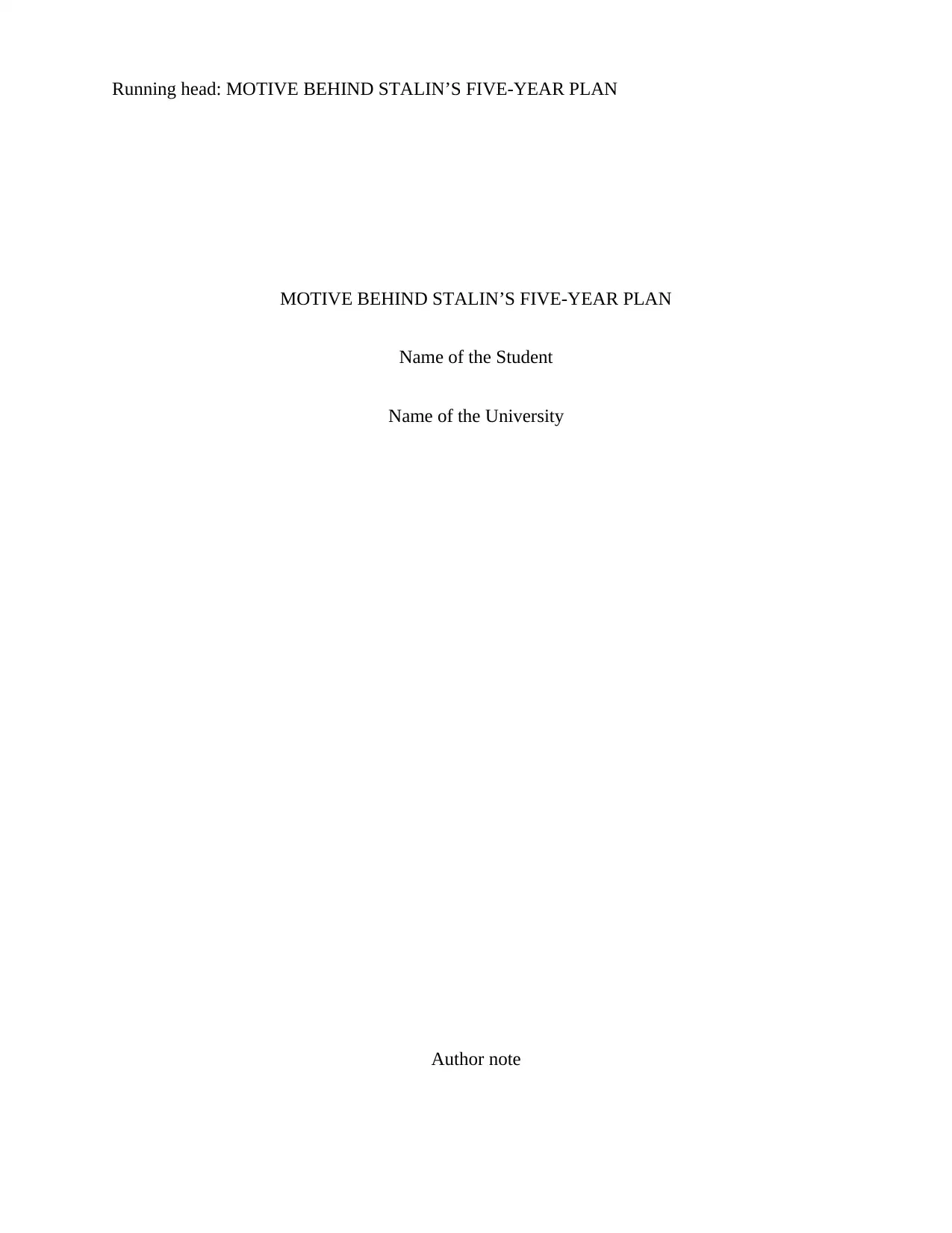
Running head: MOTIVE BEHIND STALIN’S FIVE-YEAR PLAN
MOTIVE BEHIND STALIN’S FIVE-YEAR PLAN
Name of the Student
Name of the University
Author note
MOTIVE BEHIND STALIN’S FIVE-YEAR PLAN
Name of the Student
Name of the University
Author note
Paraphrase This Document
Need a fresh take? Get an instant paraphrase of this document with our AI Paraphraser

1
MOTIVE BEHIND STALIN’S FIVE-YEAR PLAN
1. What were Stalin five-year plan attempting to do the economic, political and social
systems in Soviet Union. Why did Stalin use terror to impose these new ideas and systems?
The 19th century era was characterized by the implementation of plans and policies that
looked to make the nations powerful than others. The ideologies of Nazism, Fascism and
Stalinism mostly focused on making the country militarily powerful even at the cost of its own
citizens1. The Soviet Union under the regime of Stalin witnessed several changes in the
economic and political policies. Joseph Stalin, a revolutionary and the General Secretary of the
Soviet Union, ruled the nation during the 1920s for almost three decades before finally expiring
in 1953. After attaining supremacy of the Soviet, Stalin began to solidify his position by
eliminating all the threats including Trotsky2. He made sure that he cleaned his political party,
the citizens and even the army of those whom he thought to be his threat. When he was sure that
he had no opposition or threat, Stalin began to transform the Union in all spheres. One of his first
moves was to introduce an economic policy that would take the country at the peak of political
power. Based on this idea, he introduced the first five-year plan in 1928 until 19323. The plan
listed the economic goals created by Stalin that was based on the Socialism in One Country
policy. The plan launched by Stalin was referred to as the “revolution from above”4. The concept
referred to the idea that the nation would witness revolution brought about by the elite class. It
was designed to improve the domestic policy of the Soviet Union. The main plan however, was
focused on rapid industrialization and collectivization of agriculture. Under the new plan, Stalin
1 Kemp, Tom. Industrialization in nineteenth century Europe. Routledge, 2014.
2 Sharlet, Robert. "Stalinism and Soviet legal culture." Stalinism. Routledge, 2017. 155-179.
3 Fitzpatrick, Sheila. "New perspectives on Stalinism." The Soviet Union. Routledge, 2018. 135-151.
4 Kolchinsky, Eduard I. "Nikolai Vavilov in the years of Stalin's ‘Revolution from Above’(1929–
1932)." Centaurus 56.4 (2014): 330-358.
MOTIVE BEHIND STALIN’S FIVE-YEAR PLAN
1. What were Stalin five-year plan attempting to do the economic, political and social
systems in Soviet Union. Why did Stalin use terror to impose these new ideas and systems?
The 19th century era was characterized by the implementation of plans and policies that
looked to make the nations powerful than others. The ideologies of Nazism, Fascism and
Stalinism mostly focused on making the country militarily powerful even at the cost of its own
citizens1. The Soviet Union under the regime of Stalin witnessed several changes in the
economic and political policies. Joseph Stalin, a revolutionary and the General Secretary of the
Soviet Union, ruled the nation during the 1920s for almost three decades before finally expiring
in 1953. After attaining supremacy of the Soviet, Stalin began to solidify his position by
eliminating all the threats including Trotsky2. He made sure that he cleaned his political party,
the citizens and even the army of those whom he thought to be his threat. When he was sure that
he had no opposition or threat, Stalin began to transform the Union in all spheres. One of his first
moves was to introduce an economic policy that would take the country at the peak of political
power. Based on this idea, he introduced the first five-year plan in 1928 until 19323. The plan
listed the economic goals created by Stalin that was based on the Socialism in One Country
policy. The plan launched by Stalin was referred to as the “revolution from above”4. The concept
referred to the idea that the nation would witness revolution brought about by the elite class. It
was designed to improve the domestic policy of the Soviet Union. The main plan however, was
focused on rapid industrialization and collectivization of agriculture. Under the new plan, Stalin
1 Kemp, Tom. Industrialization in nineteenth century Europe. Routledge, 2014.
2 Sharlet, Robert. "Stalinism and Soviet legal culture." Stalinism. Routledge, 2017. 155-179.
3 Fitzpatrick, Sheila. "New perspectives on Stalinism." The Soviet Union. Routledge, 2018. 135-151.
4 Kolchinsky, Eduard I. "Nikolai Vavilov in the years of Stalin's ‘Revolution from Above’(1929–
1932)." Centaurus 56.4 (2014): 330-358.
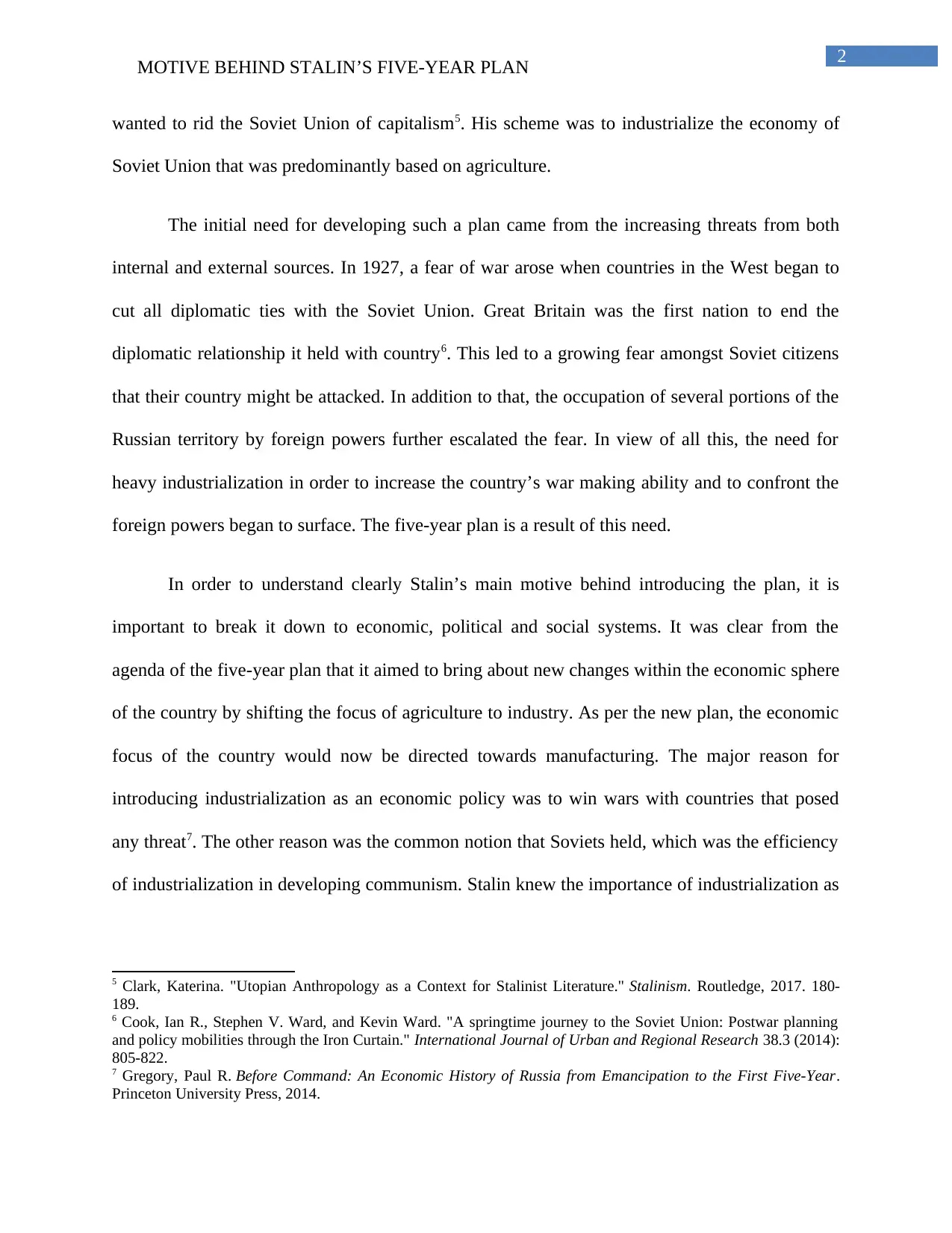
2
MOTIVE BEHIND STALIN’S FIVE-YEAR PLAN
wanted to rid the Soviet Union of capitalism5. His scheme was to industrialize the economy of
Soviet Union that was predominantly based on agriculture.
The initial need for developing such a plan came from the increasing threats from both
internal and external sources. In 1927, a fear of war arose when countries in the West began to
cut all diplomatic ties with the Soviet Union. Great Britain was the first nation to end the
diplomatic relationship it held with country6. This led to a growing fear amongst Soviet citizens
that their country might be attacked. In addition to that, the occupation of several portions of the
Russian territory by foreign powers further escalated the fear. In view of all this, the need for
heavy industrialization in order to increase the country’s war making ability and to confront the
foreign powers began to surface. The five-year plan is a result of this need.
In order to understand clearly Stalin’s main motive behind introducing the plan, it is
important to break it down to economic, political and social systems. It was clear from the
agenda of the five-year plan that it aimed to bring about new changes within the economic sphere
of the country by shifting the focus of agriculture to industry. As per the new plan, the economic
focus of the country would now be directed towards manufacturing. The major reason for
introducing industrialization as an economic policy was to win wars with countries that posed
any threat7. The other reason was the common notion that Soviets held, which was the efficiency
of industrialization in developing communism. Stalin knew the importance of industrialization as
5 Clark, Katerina. "Utopian Anthropology as a Context for Stalinist Literature." Stalinism. Routledge, 2017. 180-
189.
6 Cook, Ian R., Stephen V. Ward, and Kevin Ward. "A springtime journey to the Soviet Union: Postwar planning
and policy mobilities through the Iron Curtain." International Journal of Urban and Regional Research 38.3 (2014):
805-822.
7 Gregory, Paul R. Before Command: An Economic History of Russia from Emancipation to the First Five-Year.
Princeton University Press, 2014.
MOTIVE BEHIND STALIN’S FIVE-YEAR PLAN
wanted to rid the Soviet Union of capitalism5. His scheme was to industrialize the economy of
Soviet Union that was predominantly based on agriculture.
The initial need for developing such a plan came from the increasing threats from both
internal and external sources. In 1927, a fear of war arose when countries in the West began to
cut all diplomatic ties with the Soviet Union. Great Britain was the first nation to end the
diplomatic relationship it held with country6. This led to a growing fear amongst Soviet citizens
that their country might be attacked. In addition to that, the occupation of several portions of the
Russian territory by foreign powers further escalated the fear. In view of all this, the need for
heavy industrialization in order to increase the country’s war making ability and to confront the
foreign powers began to surface. The five-year plan is a result of this need.
In order to understand clearly Stalin’s main motive behind introducing the plan, it is
important to break it down to economic, political and social systems. It was clear from the
agenda of the five-year plan that it aimed to bring about new changes within the economic sphere
of the country by shifting the focus of agriculture to industry. As per the new plan, the economic
focus of the country would now be directed towards manufacturing. The major reason for
introducing industrialization as an economic policy was to win wars with countries that posed
any threat7. The other reason was the common notion that Soviets held, which was the efficiency
of industrialization in developing communism. Stalin knew the importance of industrialization as
5 Clark, Katerina. "Utopian Anthropology as a Context for Stalinist Literature." Stalinism. Routledge, 2017. 180-
189.
6 Cook, Ian R., Stephen V. Ward, and Kevin Ward. "A springtime journey to the Soviet Union: Postwar planning
and policy mobilities through the Iron Curtain." International Journal of Urban and Regional Research 38.3 (2014):
805-822.
7 Gregory, Paul R. Before Command: An Economic History of Russia from Emancipation to the First Five-Year.
Princeton University Press, 2014.
⊘ This is a preview!⊘
Do you want full access?
Subscribe today to unlock all pages.

Trusted by 1+ million students worldwide

3
MOTIVE BEHIND STALIN’S FIVE-YEAR PLAN
it was the most potent way to reply to all the external and internal threat. This aspect of the plan
referred to Stalin’s political motive.
As already mentioned, after Stalin’s ascendance to the throne of the Soviet Union, he
faced several threats from other political parties. In fact, Stalin’s acquisition of the Soviet power
was in doubt, as the former leader of the Soviet, Lenin, had not approved of him. However, the
proposition put forth by one of his supporters to make him the leader convinced the party to
announce Stalin as the new general secretary. Stalin knew that he would face opposition from
many of his party and hence, he wanted to introduce a plan that would make him politically more
powerful. He wanted to make sure that his political supremacy was not challenged by anyone,
from either within the country or outside. Stalin’s rejection of the New Economic Policy (NEP)
introduced by Lenin that encouraged free market and capitalism both under the control of the
state conveyed clearly his political intentions. He wanted to bring about a new system where his
decisions were not influenced the ideologies of the previous leaders.
In the social sphere, the collectivized agricultural system of the five-year plan brought
about the destruction of many farming communities like the kulaks. The process of repressing,
arresting and executing the kulaks by designating them as class enemies, known as
dekulakization led to starvations on a mass scale8. The strategy was to decrease the influence of
the kulaks in the Soviet society and bring about the supremacy of the Agitprop group within the
social sphere. Around five million kulaks lost their lives due to the human-led famine9. On the
positive side, the plan also aimed to improve the condition of the peasants by providing them
with machines that they could never afford due to poverty. The peasants now had tractors to farm
8 Rumiantsev, V., and M. Strakhov. "Law of Ukraine under the Totalitarian-Repressive Regime (1929-1939)." Law
Ukr.: Legal J. (2013): 314.
9 Cherfas, Teresa. "Reporting Stalin's famine: Jones and Muggeridge: a case study in forgetting and
rediscovery." Kritika: Explorations in Russian and Eurasian History 14.4 (2013): 775-804.
MOTIVE BEHIND STALIN’S FIVE-YEAR PLAN
it was the most potent way to reply to all the external and internal threat. This aspect of the plan
referred to Stalin’s political motive.
As already mentioned, after Stalin’s ascendance to the throne of the Soviet Union, he
faced several threats from other political parties. In fact, Stalin’s acquisition of the Soviet power
was in doubt, as the former leader of the Soviet, Lenin, had not approved of him. However, the
proposition put forth by one of his supporters to make him the leader convinced the party to
announce Stalin as the new general secretary. Stalin knew that he would face opposition from
many of his party and hence, he wanted to introduce a plan that would make him politically more
powerful. He wanted to make sure that his political supremacy was not challenged by anyone,
from either within the country or outside. Stalin’s rejection of the New Economic Policy (NEP)
introduced by Lenin that encouraged free market and capitalism both under the control of the
state conveyed clearly his political intentions. He wanted to bring about a new system where his
decisions were not influenced the ideologies of the previous leaders.
In the social sphere, the collectivized agricultural system of the five-year plan brought
about the destruction of many farming communities like the kulaks. The process of repressing,
arresting and executing the kulaks by designating them as class enemies, known as
dekulakization led to starvations on a mass scale8. The strategy was to decrease the influence of
the kulaks in the Soviet society and bring about the supremacy of the Agitprop group within the
social sphere. Around five million kulaks lost their lives due to the human-led famine9. On the
positive side, the plan also aimed to improve the condition of the peasants by providing them
with machines that they could never afford due to poverty. The peasants now had tractors to farm
8 Rumiantsev, V., and M. Strakhov. "Law of Ukraine under the Totalitarian-Repressive Regime (1929-1939)." Law
Ukr.: Legal J. (2013): 314.
9 Cherfas, Teresa. "Reporting Stalin's famine: Jones and Muggeridge: a case study in forgetting and
rediscovery." Kritika: Explorations in Russian and Eurasian History 14.4 (2013): 775-804.
Paraphrase This Document
Need a fresh take? Get an instant paraphrase of this document with our AI Paraphraser
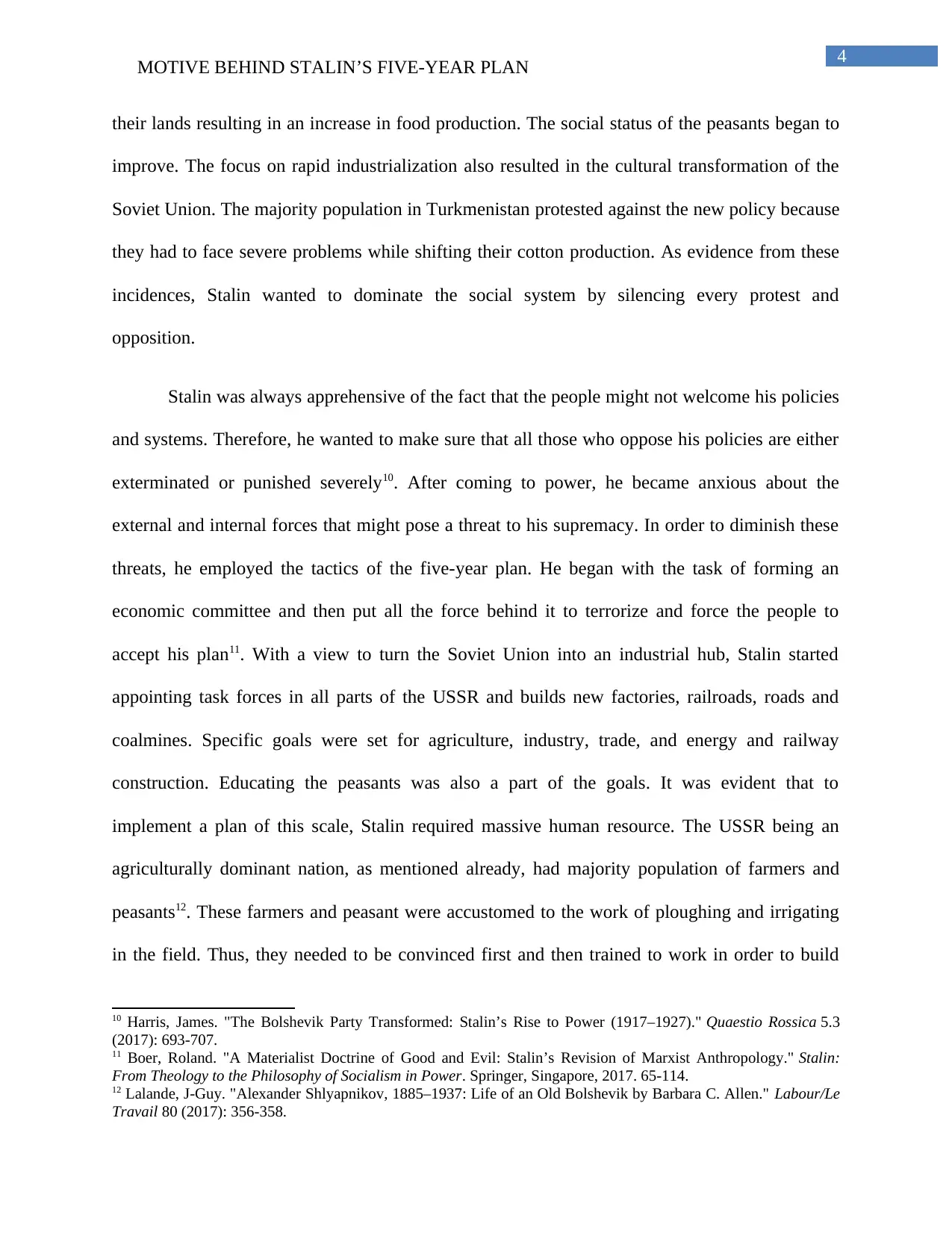
4
MOTIVE BEHIND STALIN’S FIVE-YEAR PLAN
their lands resulting in an increase in food production. The social status of the peasants began to
improve. The focus on rapid industrialization also resulted in the cultural transformation of the
Soviet Union. The majority population in Turkmenistan protested against the new policy because
they had to face severe problems while shifting their cotton production. As evidence from these
incidences, Stalin wanted to dominate the social system by silencing every protest and
opposition.
Stalin was always apprehensive of the fact that the people might not welcome his policies
and systems. Therefore, he wanted to make sure that all those who oppose his policies are either
exterminated or punished severely10. After coming to power, he became anxious about the
external and internal forces that might pose a threat to his supremacy. In order to diminish these
threats, he employed the tactics of the five-year plan. He began with the task of forming an
economic committee and then put all the force behind it to terrorize and force the people to
accept his plan11. With a view to turn the Soviet Union into an industrial hub, Stalin started
appointing task forces in all parts of the USSR and builds new factories, railroads, roads and
coalmines. Specific goals were set for agriculture, industry, trade, and energy and railway
construction. Educating the peasants was also a part of the goals. It was evident that to
implement a plan of this scale, Stalin required massive human resource. The USSR being an
agriculturally dominant nation, as mentioned already, had majority population of farmers and
peasants12. These farmers and peasant were accustomed to the work of ploughing and irrigating
in the field. Thus, they needed to be convinced first and then trained to work in order to build
10 Harris, James. "The Bolshevik Party Transformed: Stalin’s Rise to Power (1917–1927)." Quaestio Rossica 5.3
(2017): 693-707.
11 Boer, Roland. "A Materialist Doctrine of Good and Evil: Stalin’s Revision of Marxist Anthropology." Stalin:
From Theology to the Philosophy of Socialism in Power. Springer, Singapore, 2017. 65-114.
12 Lalande, J-Guy. "Alexander Shlyapnikov, 1885–1937: Life of an Old Bolshevik by Barbara C. Allen." Labour/Le
Travail 80 (2017): 356-358.
MOTIVE BEHIND STALIN’S FIVE-YEAR PLAN
their lands resulting in an increase in food production. The social status of the peasants began to
improve. The focus on rapid industrialization also resulted in the cultural transformation of the
Soviet Union. The majority population in Turkmenistan protested against the new policy because
they had to face severe problems while shifting their cotton production. As evidence from these
incidences, Stalin wanted to dominate the social system by silencing every protest and
opposition.
Stalin was always apprehensive of the fact that the people might not welcome his policies
and systems. Therefore, he wanted to make sure that all those who oppose his policies are either
exterminated or punished severely10. After coming to power, he became anxious about the
external and internal forces that might pose a threat to his supremacy. In order to diminish these
threats, he employed the tactics of the five-year plan. He began with the task of forming an
economic committee and then put all the force behind it to terrorize and force the people to
accept his plan11. With a view to turn the Soviet Union into an industrial hub, Stalin started
appointing task forces in all parts of the USSR and builds new factories, railroads, roads and
coalmines. Specific goals were set for agriculture, industry, trade, and energy and railway
construction. Educating the peasants was also a part of the goals. It was evident that to
implement a plan of this scale, Stalin required massive human resource. The USSR being an
agriculturally dominant nation, as mentioned already, had majority population of farmers and
peasants12. These farmers and peasant were accustomed to the work of ploughing and irrigating
in the field. Thus, they needed to be convinced first and then trained to work in order to build
10 Harris, James. "The Bolshevik Party Transformed: Stalin’s Rise to Power (1917–1927)." Quaestio Rossica 5.3
(2017): 693-707.
11 Boer, Roland. "A Materialist Doctrine of Good and Evil: Stalin’s Revision of Marxist Anthropology." Stalin:
From Theology to the Philosophy of Socialism in Power. Springer, Singapore, 2017. 65-114.
12 Lalande, J-Guy. "Alexander Shlyapnikov, 1885–1937: Life of an Old Bolshevik by Barbara C. Allen." Labour/Le
Travail 80 (2017): 356-358.
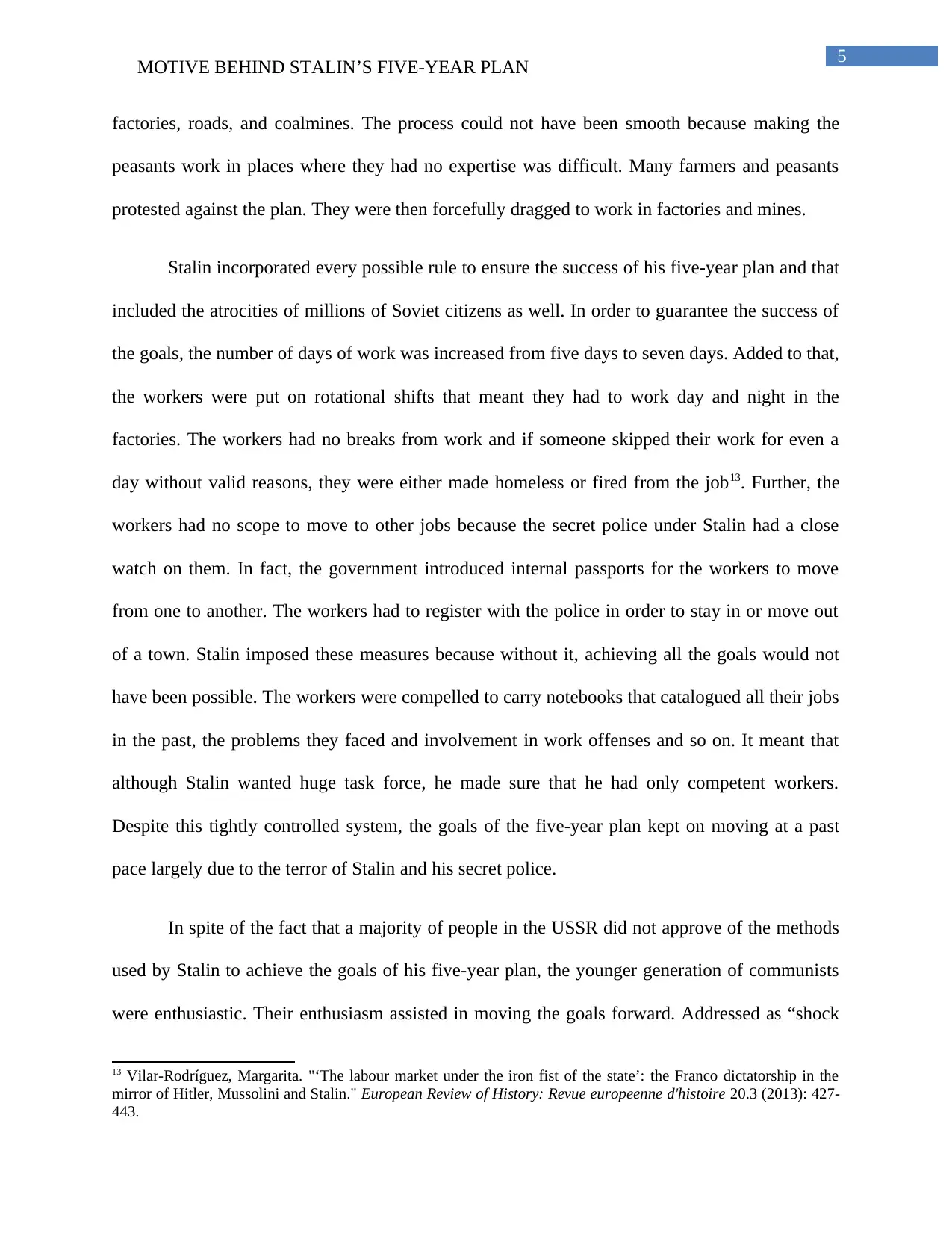
5
MOTIVE BEHIND STALIN’S FIVE-YEAR PLAN
factories, roads, and coalmines. The process could not have been smooth because making the
peasants work in places where they had no expertise was difficult. Many farmers and peasants
protested against the plan. They were then forcefully dragged to work in factories and mines.
Stalin incorporated every possible rule to ensure the success of his five-year plan and that
included the atrocities of millions of Soviet citizens as well. In order to guarantee the success of
the goals, the number of days of work was increased from five days to seven days. Added to that,
the workers were put on rotational shifts that meant they had to work day and night in the
factories. The workers had no breaks from work and if someone skipped their work for even a
day without valid reasons, they were either made homeless or fired from the job13. Further, the
workers had no scope to move to other jobs because the secret police under Stalin had a close
watch on them. In fact, the government introduced internal passports for the workers to move
from one to another. The workers had to register with the police in order to stay in or move out
of a town. Stalin imposed these measures because without it, achieving all the goals would not
have been possible. The workers were compelled to carry notebooks that catalogued all their jobs
in the past, the problems they faced and involvement in work offenses and so on. It meant that
although Stalin wanted huge task force, he made sure that he had only competent workers.
Despite this tightly controlled system, the goals of the five-year plan kept on moving at a past
pace largely due to the terror of Stalin and his secret police.
In spite of the fact that a majority of people in the USSR did not approve of the methods
used by Stalin to achieve the goals of his five-year plan, the younger generation of communists
were enthusiastic. Their enthusiasm assisted in moving the goals forward. Addressed as “shock
13 Vilar-Rodríguez, Margarita. "‘The labour market under the iron fist of the state’: the Franco dictatorship in the
mirror of Hitler, Mussolini and Stalin." European Review of History: Revue europeenne d'histoire 20.3 (2013): 427-
443.
MOTIVE BEHIND STALIN’S FIVE-YEAR PLAN
factories, roads, and coalmines. The process could not have been smooth because making the
peasants work in places where they had no expertise was difficult. Many farmers and peasants
protested against the plan. They were then forcefully dragged to work in factories and mines.
Stalin incorporated every possible rule to ensure the success of his five-year plan and that
included the atrocities of millions of Soviet citizens as well. In order to guarantee the success of
the goals, the number of days of work was increased from five days to seven days. Added to that,
the workers were put on rotational shifts that meant they had to work day and night in the
factories. The workers had no breaks from work and if someone skipped their work for even a
day without valid reasons, they were either made homeless or fired from the job13. Further, the
workers had no scope to move to other jobs because the secret police under Stalin had a close
watch on them. In fact, the government introduced internal passports for the workers to move
from one to another. The workers had to register with the police in order to stay in or move out
of a town. Stalin imposed these measures because without it, achieving all the goals would not
have been possible. The workers were compelled to carry notebooks that catalogued all their jobs
in the past, the problems they faced and involvement in work offenses and so on. It meant that
although Stalin wanted huge task force, he made sure that he had only competent workers.
Despite this tightly controlled system, the goals of the five-year plan kept on moving at a past
pace largely due to the terror of Stalin and his secret police.
In spite of the fact that a majority of people in the USSR did not approve of the methods
used by Stalin to achieve the goals of his five-year plan, the younger generation of communists
were enthusiastic. Their enthusiasm assisted in moving the goals forward. Addressed as “shock
13 Vilar-Rodríguez, Margarita. "‘The labour market under the iron fist of the state’: the Franco dictatorship in the
mirror of Hitler, Mussolini and Stalin." European Review of History: Revue europeenne d'histoire 20.3 (2013): 427-
443.
⊘ This is a preview!⊘
Do you want full access?
Subscribe today to unlock all pages.

Trusted by 1+ million students worldwide
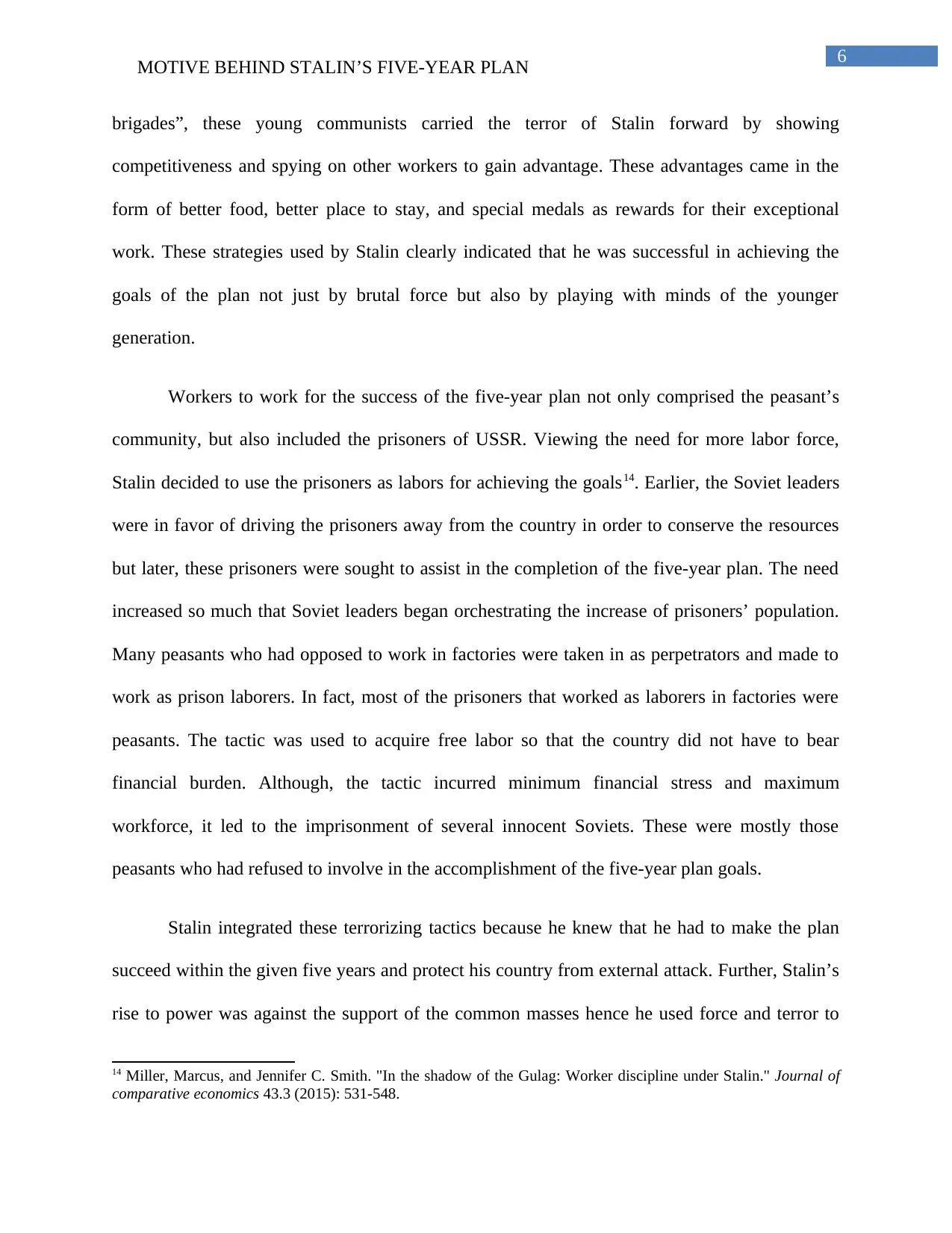
6
MOTIVE BEHIND STALIN’S FIVE-YEAR PLAN
brigades”, these young communists carried the terror of Stalin forward by showing
competitiveness and spying on other workers to gain advantage. These advantages came in the
form of better food, better place to stay, and special medals as rewards for their exceptional
work. These strategies used by Stalin clearly indicated that he was successful in achieving the
goals of the plan not just by brutal force but also by playing with minds of the younger
generation.
Workers to work for the success of the five-year plan not only comprised the peasant’s
community, but also included the prisoners of USSR. Viewing the need for more labor force,
Stalin decided to use the prisoners as labors for achieving the goals14. Earlier, the Soviet leaders
were in favor of driving the prisoners away from the country in order to conserve the resources
but later, these prisoners were sought to assist in the completion of the five-year plan. The need
increased so much that Soviet leaders began orchestrating the increase of prisoners’ population.
Many peasants who had opposed to work in factories were taken in as perpetrators and made to
work as prison laborers. In fact, most of the prisoners that worked as laborers in factories were
peasants. The tactic was used to acquire free labor so that the country did not have to bear
financial burden. Although, the tactic incurred minimum financial stress and maximum
workforce, it led to the imprisonment of several innocent Soviets. These were mostly those
peasants who had refused to involve in the accomplishment of the five-year plan goals.
Stalin integrated these terrorizing tactics because he knew that he had to make the plan
succeed within the given five years and protect his country from external attack. Further, Stalin’s
rise to power was against the support of the common masses hence he used force and terror to
14 Miller, Marcus, and Jennifer C. Smith. "In the shadow of the Gulag: Worker discipline under Stalin." Journal of
comparative economics 43.3 (2015): 531-548.
MOTIVE BEHIND STALIN’S FIVE-YEAR PLAN
brigades”, these young communists carried the terror of Stalin forward by showing
competitiveness and spying on other workers to gain advantage. These advantages came in the
form of better food, better place to stay, and special medals as rewards for their exceptional
work. These strategies used by Stalin clearly indicated that he was successful in achieving the
goals of the plan not just by brutal force but also by playing with minds of the younger
generation.
Workers to work for the success of the five-year plan not only comprised the peasant’s
community, but also included the prisoners of USSR. Viewing the need for more labor force,
Stalin decided to use the prisoners as labors for achieving the goals14. Earlier, the Soviet leaders
were in favor of driving the prisoners away from the country in order to conserve the resources
but later, these prisoners were sought to assist in the completion of the five-year plan. The need
increased so much that Soviet leaders began orchestrating the increase of prisoners’ population.
Many peasants who had opposed to work in factories were taken in as perpetrators and made to
work as prison laborers. In fact, most of the prisoners that worked as laborers in factories were
peasants. The tactic was used to acquire free labor so that the country did not have to bear
financial burden. Although, the tactic incurred minimum financial stress and maximum
workforce, it led to the imprisonment of several innocent Soviets. These were mostly those
peasants who had refused to involve in the accomplishment of the five-year plan goals.
Stalin integrated these terrorizing tactics because he knew that he had to make the plan
succeed within the given five years and protect his country from external attack. Further, Stalin’s
rise to power was against the support of the common masses hence he used force and terror to
14 Miller, Marcus, and Jennifer C. Smith. "In the shadow of the Gulag: Worker discipline under Stalin." Journal of
comparative economics 43.3 (2015): 531-548.
Paraphrase This Document
Need a fresh take? Get an instant paraphrase of this document with our AI Paraphraser
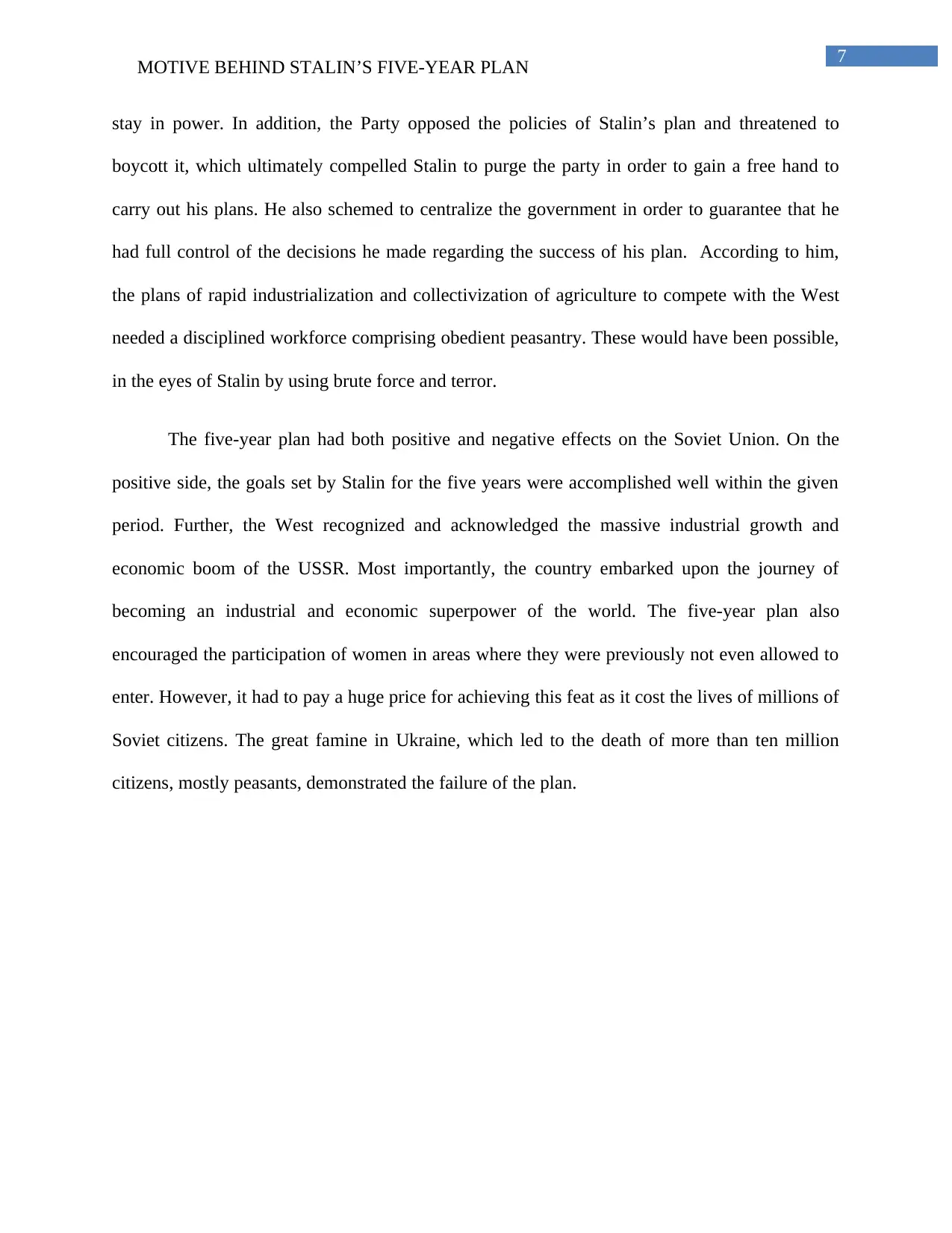
7
MOTIVE BEHIND STALIN’S FIVE-YEAR PLAN
stay in power. In addition, the Party opposed the policies of Stalin’s plan and threatened to
boycott it, which ultimately compelled Stalin to purge the party in order to gain a free hand to
carry out his plans. He also schemed to centralize the government in order to guarantee that he
had full control of the decisions he made regarding the success of his plan. According to him,
the plans of rapid industrialization and collectivization of agriculture to compete with the West
needed a disciplined workforce comprising obedient peasantry. These would have been possible,
in the eyes of Stalin by using brute force and terror.
The five-year plan had both positive and negative effects on the Soviet Union. On the
positive side, the goals set by Stalin for the five years were accomplished well within the given
period. Further, the West recognized and acknowledged the massive industrial growth and
economic boom of the USSR. Most importantly, the country embarked upon the journey of
becoming an industrial and economic superpower of the world. The five-year plan also
encouraged the participation of women in areas where they were previously not even allowed to
enter. However, it had to pay a huge price for achieving this feat as it cost the lives of millions of
Soviet citizens. The great famine in Ukraine, which led to the death of more than ten million
citizens, mostly peasants, demonstrated the failure of the plan.
MOTIVE BEHIND STALIN’S FIVE-YEAR PLAN
stay in power. In addition, the Party opposed the policies of Stalin’s plan and threatened to
boycott it, which ultimately compelled Stalin to purge the party in order to gain a free hand to
carry out his plans. He also schemed to centralize the government in order to guarantee that he
had full control of the decisions he made regarding the success of his plan. According to him,
the plans of rapid industrialization and collectivization of agriculture to compete with the West
needed a disciplined workforce comprising obedient peasantry. These would have been possible,
in the eyes of Stalin by using brute force and terror.
The five-year plan had both positive and negative effects on the Soviet Union. On the
positive side, the goals set by Stalin for the five years were accomplished well within the given
period. Further, the West recognized and acknowledged the massive industrial growth and
economic boom of the USSR. Most importantly, the country embarked upon the journey of
becoming an industrial and economic superpower of the world. The five-year plan also
encouraged the participation of women in areas where they were previously not even allowed to
enter. However, it had to pay a huge price for achieving this feat as it cost the lives of millions of
Soviet citizens. The great famine in Ukraine, which led to the death of more than ten million
citizens, mostly peasants, demonstrated the failure of the plan.

8
MOTIVE BEHIND STALIN’S FIVE-YEAR PLAN
References:
Boer, Roland. "A Materialist Doctrine of Good and Evil: Stalin’s Revision of Marxist
Anthropology." Stalin: From Theology to the Philosophy of Socialism in Power. Springer,
Singapore, 2017. 65-114.
Cherfas, Teresa. "Reporting Stalin's famine: Jones and Muggeridge: a case study in forgetting
and rediscovery." Kritika: Explorations in Russian and Eurasian History 14.4 (2013): 775-804.
Clark, Katerina. "Utopian Anthropology as a Context for Stalinist Literature." Stalinism.
Routledge, 2017. 180-189.
Cook, Ian R., Stephen V. Ward, and Kevin Ward. "A springtime journey to the Soviet Union:
Postwar planning and policy mobilities through the Iron Curtain." International Journal of
Urban and Regional Research 38.3 (2014): 805-822.
Fitzpatrick, Sheila. "New perspectives on Stalinism." The Soviet Union. Routledge, 2018. 135-
151.
Gregory, Paul R. Before Command: An Economic History of Russia from Emancipation to the
First Five-Year. Princeton University Press, 2014.
Hanson, Philip. The Rise and Fall of the The Soviet Economy: An Economic History of the USSR
1945-1991. Routledge, 2014.
Harris, James. "The Bolshevik Party Transformed: Stalin’s Rise to Power (1917–
1927)." Quaestio Rossica 5.3 (2017): 693-707.
Kemp, Tom. Industrialization in nineteenth century Europe. Routledge, 2014.
MOTIVE BEHIND STALIN’S FIVE-YEAR PLAN
References:
Boer, Roland. "A Materialist Doctrine of Good and Evil: Stalin’s Revision of Marxist
Anthropology." Stalin: From Theology to the Philosophy of Socialism in Power. Springer,
Singapore, 2017. 65-114.
Cherfas, Teresa. "Reporting Stalin's famine: Jones and Muggeridge: a case study in forgetting
and rediscovery." Kritika: Explorations in Russian and Eurasian History 14.4 (2013): 775-804.
Clark, Katerina. "Utopian Anthropology as a Context for Stalinist Literature." Stalinism.
Routledge, 2017. 180-189.
Cook, Ian R., Stephen V. Ward, and Kevin Ward. "A springtime journey to the Soviet Union:
Postwar planning and policy mobilities through the Iron Curtain." International Journal of
Urban and Regional Research 38.3 (2014): 805-822.
Fitzpatrick, Sheila. "New perspectives on Stalinism." The Soviet Union. Routledge, 2018. 135-
151.
Gregory, Paul R. Before Command: An Economic History of Russia from Emancipation to the
First Five-Year. Princeton University Press, 2014.
Hanson, Philip. The Rise and Fall of the The Soviet Economy: An Economic History of the USSR
1945-1991. Routledge, 2014.
Harris, James. "The Bolshevik Party Transformed: Stalin’s Rise to Power (1917–
1927)." Quaestio Rossica 5.3 (2017): 693-707.
Kemp, Tom. Industrialization in nineteenth century Europe. Routledge, 2014.
⊘ This is a preview!⊘
Do you want full access?
Subscribe today to unlock all pages.

Trusted by 1+ million students worldwide
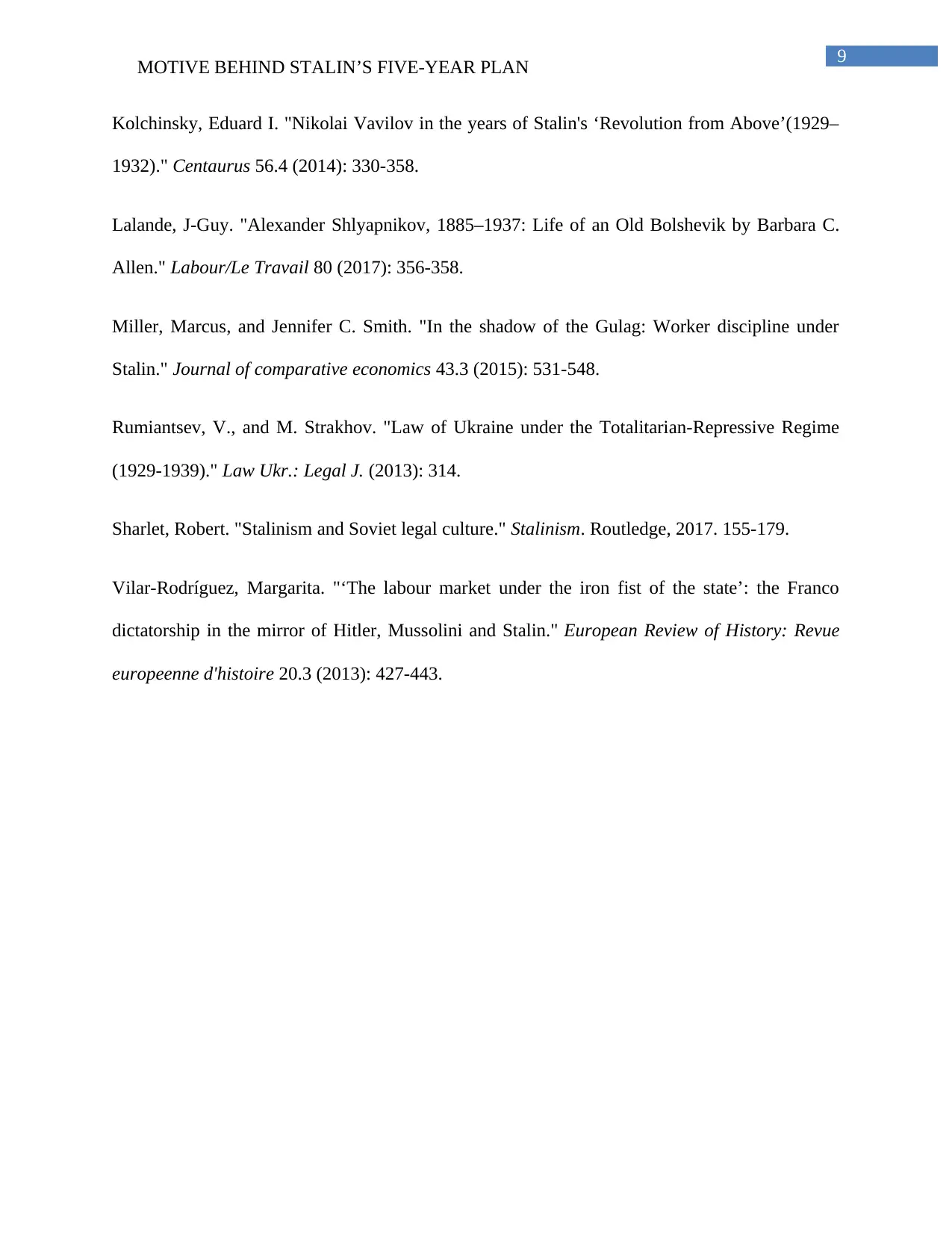
9
MOTIVE BEHIND STALIN’S FIVE-YEAR PLAN
Kolchinsky, Eduard I. "Nikolai Vavilov in the years of Stalin's ‘Revolution from Above’(1929–
1932)." Centaurus 56.4 (2014): 330-358.
Lalande, J-Guy. "Alexander Shlyapnikov, 1885–1937: Life of an Old Bolshevik by Barbara C.
Allen." Labour/Le Travail 80 (2017): 356-358.
Miller, Marcus, and Jennifer C. Smith. "In the shadow of the Gulag: Worker discipline under
Stalin." Journal of comparative economics 43.3 (2015): 531-548.
Rumiantsev, V., and M. Strakhov. "Law of Ukraine under the Totalitarian-Repressive Regime
(1929-1939)." Law Ukr.: Legal J. (2013): 314.
Sharlet, Robert. "Stalinism and Soviet legal culture." Stalinism. Routledge, 2017. 155-179.
Vilar-Rodríguez, Margarita. "‘The labour market under the iron fist of the state’: the Franco
dictatorship in the mirror of Hitler, Mussolini and Stalin." European Review of History: Revue
europeenne d'histoire 20.3 (2013): 427-443.
MOTIVE BEHIND STALIN’S FIVE-YEAR PLAN
Kolchinsky, Eduard I. "Nikolai Vavilov in the years of Stalin's ‘Revolution from Above’(1929–
1932)." Centaurus 56.4 (2014): 330-358.
Lalande, J-Guy. "Alexander Shlyapnikov, 1885–1937: Life of an Old Bolshevik by Barbara C.
Allen." Labour/Le Travail 80 (2017): 356-358.
Miller, Marcus, and Jennifer C. Smith. "In the shadow of the Gulag: Worker discipline under
Stalin." Journal of comparative economics 43.3 (2015): 531-548.
Rumiantsev, V., and M. Strakhov. "Law of Ukraine under the Totalitarian-Repressive Regime
(1929-1939)." Law Ukr.: Legal J. (2013): 314.
Sharlet, Robert. "Stalinism and Soviet legal culture." Stalinism. Routledge, 2017. 155-179.
Vilar-Rodríguez, Margarita. "‘The labour market under the iron fist of the state’: the Franco
dictatorship in the mirror of Hitler, Mussolini and Stalin." European Review of History: Revue
europeenne d'histoire 20.3 (2013): 427-443.
1 out of 10
Related Documents
Your All-in-One AI-Powered Toolkit for Academic Success.
+13062052269
info@desklib.com
Available 24*7 on WhatsApp / Email
![[object Object]](/_next/static/media/star-bottom.7253800d.svg)
Unlock your academic potential
Copyright © 2020–2025 A2Z Services. All Rights Reserved. Developed and managed by ZUCOL.





